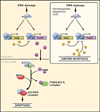Slugging it out: fine tuning the p53-PUMA death connection
- PMID: 16286002
- PMCID: PMC4578637
- DOI: 10.1016/j.cell.2005.11.003
Slugging it out: fine tuning the p53-PUMA death connection
Abstract
In response to DNA damage, the tumor suppressor p53 elicits a complex cellular response. In this issue of Cell, Wu et al. (2005) show that the transcription factor SLUG is induced by p53 and protects hematopoietic progenitor cells from apoptosis triggered by DNA damage. SLUG exerts this protective role by repressing Puma, a proapoptotic target of p53. PUMA is also a key coordinator of apoptosis mediated by both nuclear and cytoplasmic functions of p53 (Chi-puk et al., 2005).
Figures

Comment on
-
Slug antagonizes p53-mediated apoptosis of hematopoietic progenitors by repressing puma.Cell. 2005 Nov 18;123(4):641-53. doi: 10.1016/j.cell.2005.09.029. Cell. 2005. PMID: 16286009
Similar articles
-
Slug antagonizes p53-mediated apoptosis of hematopoietic progenitors by repressing puma.Cell. 2005 Nov 18;123(4):641-53. doi: 10.1016/j.cell.2005.09.029. Cell. 2005. PMID: 16286009
-
PUMA, a potent killer with or without p53.Oncogene. 2008 Dec;27 Suppl 1(Suppl 1):S71-83. doi: 10.1038/onc.2009.45. Oncogene. 2008. PMID: 19641508 Free PMC article. Review.
-
SLUGging away at cell death.Cancer Cell. 2002 Oct;2(4):249-51. doi: 10.1016/s1535-6108(02)00156-3. Cancer Cell. 2002. PMID: 12398886
-
PUMA couples the nuclear and cytoplasmic proapoptotic function of p53.Science. 2005 Sep 9;309(5741):1732-5. doi: 10.1126/science.1114297. Science. 2005. PMID: 16151013
-
Clues from worms: a Slug at Puma promotes the survival of blood progenitors.Cell Death Differ. 2006 Jun;13(6):913-5. doi: 10.1038/sj.cdd.4401906. Cell Death Differ. 2006. PMID: 16543938 Review. No abstract available.
Cited by
-
A matter of life and death: stem cell survival in tissue regeneration and tumour formation.Nat Rev Cancer. 2018 Mar;18(3):187-201. doi: 10.1038/nrc.2017.122. Epub 2018 Jan 19. Nat Rev Cancer. 2018. PMID: 29348578 Review.
-
New insights of epithelial-mesenchymal transition in cancer metastasis.Acta Biochim Biophys Sin (Shanghai). 2008 Jul;40(7):643-50. doi: 10.1111/j.1745-7270.2008.00443.x. Acta Biochim Biophys Sin (Shanghai). 2008. PMID: 18604456 Free PMC article. Review.
-
High motility of triple-negative breast cancer cells is due to repression of plakoglobin gene by metastasis modulator protein SLUG.J Biol Chem. 2012 Jun 1;287(23):19472-86. doi: 10.1074/jbc.M112.345728. Epub 2012 Apr 11. J Biol Chem. 2012. PMID: 22496452 Free PMC article.
-
Mare stromal endometrial cells differentially modulate inflammation depending on oestrus cycle status: an in vitro study.Front Vet Sci. 2023 Oct 6;10:1271240. doi: 10.3389/fvets.2023.1271240. eCollection 2023. Front Vet Sci. 2023. PMID: 37869492 Free PMC article.
-
p53-Dependent induction of PVT1 and miR-1204.J Biol Chem. 2012 Jan 20;287(4):2509-19. doi: 10.1074/jbc.M111.322875. Epub 2011 Nov 22. J Biol Chem. 2012. PMID: 22110125 Free PMC article.
References
Publication types
MeSH terms
Substances
Grants and funding
LinkOut - more resources
Full Text Sources
Research Materials
Miscellaneous

